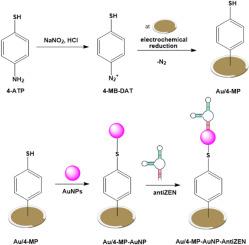用石英晶体微天平测定适配体电化学纳米膜上的玉米赤霉烯酮
IF 2.4
4区 医学
Q2 PHARMACOLOGY & PHARMACY
引用次数: 0
摘要
玉米赤霉烯酮(ZEN)是一种剧毒真菌毒素,是各种镰刀菌的次生代谢产物。为了检测谷物产品中的这种污染物,我们开发了一种基于石英晶体微天平(QCM)的适体传感器。为了放大传感器信号,在晶体表面形成电化学沉积的重氮衍生膜,随后在该膜上装饰金纳米粒子以促进适配体的固定。在传感器制造过程中使用的所有材料和修饰表面都通过UV-vis进行了全面表征。光谱学、透射电子显微镜、循环伏安法和x射线光电子能谱学。在优化条件下,QCM传感器对ZEN的线性检测范围为0.1 ~ 250 ng/mL,检出限为0.182 ng/mL。对潜在干扰物(包括赭曲霉毒素A、B和黄曲霉毒素B1)的选择性进行了评估,干扰效果仍在可接受的重复性范围内。动力学分析表明,伪二阶动力学拟合和较高ZEN浓度下Kd值的增加证明了这种表面受限的传质相互作用,得到的平均解离常数为128±153 ng/mL。最后,该传感器成功地定量了小麦和玉米样品中的ZEN,回收率在95% ~ 105%之间。本文章由计算机程序翻译,如有差异,请以英文原文为准。

Determination of zearalenone on aptamer-based electrochemical nanofilm using quartz crystal microbalance
Zearalenone (ZEN) is a highly toxic mycotoxin produced as a secondary metabolite by various Fusarium species. To detect this contaminant in cereal products, we developed a quartz crystal microbalance (QCM)–based aptasensor. To amplify the sensor signal, an electrochemically deposited diazonium-derived film was formed on the crystal surface, and gold nanoparticles were subsequently decorated on this film to facilitate aptamer immobilization. All materials and modified surfaces used during sensor fabrication were thoroughly characterized by UV–vis. spectroscopy, transmission electron microscopy, cyclic voltammetry, and X-ray photoelectron spectroscopy. Under optimized conditions, the QCM aptasensor exhibited a linear detection range of 0.1–250 ng/mL for ZEN, with a limit of detection of 0.182 ng/mL. Its selectivity was evaluated against potential interferents, including ochratoxin A and B and aflatoxin B1, and interference effects remained within acceptable reproducibility limits. Kinetic analysis demonstrated a surface-confined, mass-transfer-limited interaction, as evidenced by the pseudo-second-order kinetic fit and the increasing Kd values at higher ZEN concentrations, yielding an average dissociation constant of 128 ± 153 ng/mL. Finally, the aptasensor successfully quantified ZEN in spiked wheat and corn samples, yielding recoveries between 95 % and 105 %.
求助全文
通过发布文献求助,成功后即可免费获取论文全文。
去求助
来源期刊

Toxicon
医学-毒理学
CiteScore
4.80
自引率
10.70%
发文量
358
审稿时长
68 days
期刊介绍:
Toxicon has an open access mirror Toxicon: X, sharing the same aims and scope, editorial team, submission system and rigorous peer review. An introductory offer Toxicon: X - full waiver of the Open Access fee.
Toxicon''s "aims and scope" are to publish:
-articles containing the results of original research on problems related to toxins derived from animals, plants and microorganisms
-papers on novel findings related to the chemical, pharmacological, toxicological, and immunological properties of natural toxins
-molecular biological studies of toxins and other genes from poisonous and venomous organisms that advance understanding of the role or function of toxins
-clinical observations on poisoning and envenoming where a new therapeutic principle has been proposed or a decidedly superior clinical result has been obtained.
-material on the use of toxins as tools in studying biological processes and material on subjects related to venom and antivenom problems.
-articles on the translational application of toxins, for example as drugs and insecticides
-epidemiological studies on envenoming or poisoning, so long as they highlight a previously unrecognised medical problem or provide insight into the prevention or medical treatment of envenoming or poisoning. Retrospective surveys of hospital records, especially those lacking species identification, will not be considered for publication. Properly designed prospective community-based surveys are strongly encouraged.
-articles describing well-known activities of venoms, such as antibacterial, anticancer, and analgesic activities of arachnid venoms, without any attempt to define the mechanism of action or purify the active component, will not be considered for publication in Toxicon.
-review articles on problems related to toxinology.
To encourage the exchange of ideas, sections of the journal may be devoted to Short Communications, Letters to the Editor and activities of the affiliated societies.
 求助内容:
求助内容: 应助结果提醒方式:
应助结果提醒方式:


